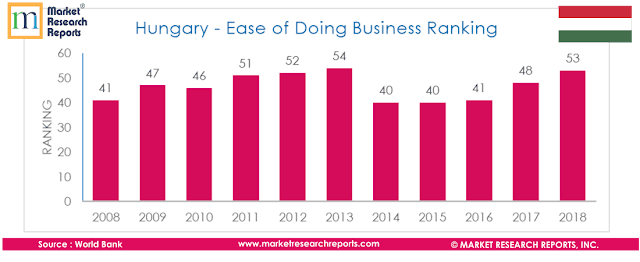Hungary’s economic growth is expected to slow down in the next two
years which will result in rising imports to meet domestic demand. Increasing
real-wage gains and record-high employment is expected to boost private
consumption. Hungary’s housing sector growth is expected to decrease due to
re-introduction of VAT on new buildings from 2019.
Hungary is expected to be vulnerable to financial turmoil in
emerging-market economies and a hard Brexit is expected to hurt Hungary’s
exports and business confidence. Tight labour market conditions are expected to
raise inflation which is projected to reach 4% in 2019.
In World Bank’s ease of doing business ranking Hungary was ranked 53
out of 190 countries in 2018. Hungary’s ease of doing business ranking slipped
from 48th position in 2017.
Hungary is a landlocked state with many neighbours – Slovakia, Ukraine,
Romania, Serbia, Croatia, Slovenia and Austria. It is mostly flat, with low
mountains in the north. Lake Balaton, a popular tourist centre, is the largest
lake in central Europe. The capital city, Budapest, was originally was two
separate cities: Buda and Pest. It straddles the River Danube, is rich in
history and culture and famed for its curative springs. Hungary has a
single-chamber parliament or national assembly whose 386 members are elected by
voters every four years.
Hungary had estimated population of 9.835 million in the year 2016 and
expected to reach 9.71 million by 2022. Hungary’s unemployment rate was 4.883%
of total labor force.
Hungary’s real gross domestic product (GDP) was around HUF 24897.02
billions in 2016 whereas the nominal GDP was HUF 35372.57 billions. This
resulted in GDP deflator 142.076. Per capita GDP was estimated at USD 12778.29
whereas purchasing power parity (PPP) based per capita GDP was estimated to be
at USD 27481.79.
In 2016, Hungary government’s revenue was HUF 16202.36 billions whereas
the expenditure was HUF 16844.50 billions. This resulted Hungary government’s
net lending / borrowing negative at HUF 642.145 billion in 2016 indicating that
enough financial resources were not made available by the government to boost
economic growth.
The current account balance for Hungary was estimated to be at USD
5.434 billions for the year 2016 and is expected to decline at a CAGR of 12.89%
and reach USD 1.569 by 2022. This positive current account balance indicates
the Hungary is net lender to the whole world.
Scope of Hungary – PESTLE Analysis and Macroeconomic Trends Report
- This report provides information about key macroeconomic indicators for Hungary.
- This report provides PESTELE (political, economic, social, technological, environmental and legal) analysis for Hungary.
For more information and to purchase Hungary PESTLE Analysis &
Macroeconomic Trends Market Research Report please visit: https://www.marketresearchreports.com/market-research-reports-inc/hungary-pestle-analysis-macroeconomic-trends-market-research-report
For more information and Other PESTLE Analysis Market Research Report
please visit: https://www.marketresearchreports.com/pestle-analysis
About MarketResearchReports.com
MarketResearchReports.com
is world's largest store offering quality market research, SWOT analysis,
competitive intelligence and industry reports. We help Fortune 500 to Start-Ups
with the latest market research reports on global markets which comprise key
industries, leading market players, new products and latest industry analysis
& trends.
Contact us for your market research requirements: http://www.marketresearchreports.com/contact

No comments:
Post a Comment